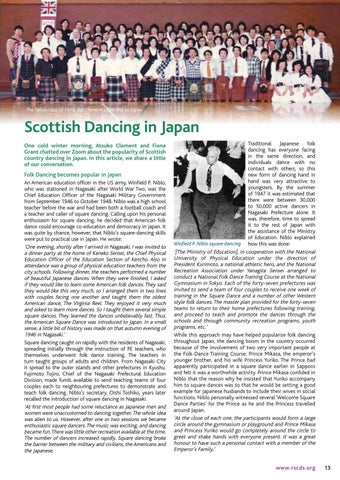The Tokyo class of 1975: Bill Clement’s first trip to Japan
Scottish Dancing in Japan One cold winter morning, Atsuko Clement and Fiona Grant chatted over Zoom about the popularity of Scottish country dancing in Japan. In this article, we share a little of our conversation.
Folk Dancing becomes popular in Japan An American education officer in the US army, Winfield P. Niblo, who was stationed in Nagasaki after World War Two, was the Chief Education Officer of the Nagasaki Military Government from September 1946 to October 1948. Niblo was a high school teacher before the war and had been both a football coach and a teacher and caller of square dancing. Calling upon his personal enthusiasm for square dancing, he decided that American folk dance could encourage co-education and democracy in Japan. It was quite by chance, however, that Niblo’s square-dancing skills were put to practical use in Japan. He wrote: ‘One evening, shortly after I arrived in Nagasaki, I was invited to a dinner party at the home of Kaneko Sensei, the Chief Physical Education Officer of the Education Section of Kencho. Also in attendance was a group of physical education teachers from the city schools. Following dinner, the teachers performed a number of beautiful Japanese dances. When they were finished, I asked if they would like to learn some American folk dances. They said they would like this very much, so I arranged them in two lines with couples facing one another and taught them the oldest American dance, The Virginia Reel. They enjoyed it very much and asked to learn more dances. So I taught them several simple square dances. They learned the dances unbelievably fast. Thus, the American Square Dance was introduced to Japan. In a small sense, a little bit of history was made on that autumn evening of 1946 in Nagasaki.’ Square dancing caught on rapidly with the residents of Nagasaki, spreading initially through the instruction of PE teachers, who themselves underwent folk dance training. The teachers in turn taught groups of adults and children. From Nagasaki City it spread to the outer islands and other prefectures in Kyushu. Fujimoto Tojiro, Chief of the Nagasaki Prefectural Education Division, made funds available to send teaching teams of four couples each to neighbouring prefectures to demonstrate and teach folk dancing. Niblo’s secretary, Oishi Toshiko, years later recalled the introduction of square dancing in Nagasaki. ‘At first most people had some reluctance as Japanese men and women were unaccustomed to dancing together. The whole idea was alien to us. However, after one or two sessions we became enthusiastic square dancers. The music was exciting, and dancing became fun. There was little other recreation available at the time. The number of dancers increased rapidly. Square dancing broke the barrier between the military and civilians, the Americans and the Japanese.
Traditional Japanese folk dancing has everyone facing in the same direction, and individuals dance with no contact with others, so this new form of dancing hand in hand was very attractive to youngsters. By the summer of 1947 it was estimated that there were between 30,000 to 50,000 active dancers in Nagasaki Prefecture alone. It was, therefore, time to spread it to the rest of Japan with the assistance of the Ministry of Education. Niblo explained Winfield P. Niblo square dancing how this was done: ‘[The Ministry of Education], in cooperation with the National University of Physical Education under the direction of President Kurimoto, a national athletic hero, and the National Recreation Association under Yanagita Sensei arranged to conduct a National Folk Dance Training Course at the National Gymnasium in Tokyo. Each of the forty-seven prefectures was invited to send a team of four couples to receive one week of training in the Square Dance and a number of other Western style folk dances. The master plan provided for the forty-seven teams to return to their home prefectures following training, and proceed to teach and promote the dances through the schools and through community recreation programs, youth programs, etc.’ While this approach may have helped popularize folk dancing throughout Japan, the dancing boom in the country occurred because of the involvement of two very important people at the Folk-Dance Training Course: Prince Mikasa, the emperor’s younger brother, and his wife Princess Yuriko. The Prince had apparently participated in a square dance earlier in Sapporo and felt it was a worthwhile activity. Prince Mikasa confided in Niblo that the reason why he insisted that Yuriko accompany him to square dances was so that he would be setting a good example for Japanese husbands to include their wives in social functions. Niblo personally witnessed several ‘Welcome Square Dance Parties’ for the Prince as he and the Princess travelled around Japan. ‘At the close of each one, the participants would form a large circle around the gymnasium or playground and Prince Mikasa and Princess Yuriko would go completely around the circle to greet and shake hands with everyone present. It was a great honour to have such a personal contact with a member of the Emperor’s Family.’
www.rscds.org
13














